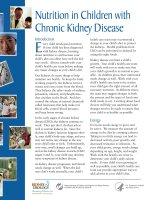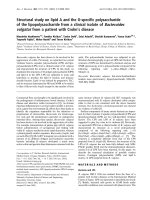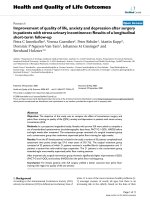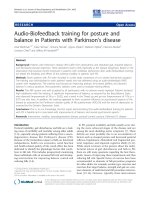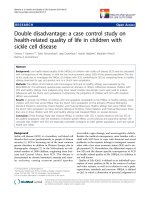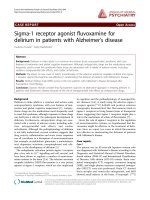Is Lactobacillus GG Helpful in Children With Crohn’s Disease? Results of a Preliminary, Open-Label Study docx
Bạn đang xem bản rút gọn của tài liệu. Xem và tải ngay bản đầy đủ của tài liệu tại đây (596.12 KB, 5 trang )
Short Communication
Is Lactobacillus GG Helpful in Children With Crohn’s Disease?
Results of a Preliminary, Open-Label Study
Puneet Gupta, Haikaeli Andrew, Barbara S. Kirschner, and Stefano Guandalini
Section of Pediatric Gastroenterology, Hepatology and Nutrition, The University of Chicago Children’s Hospital,
Chicago, Illinois, U.S.A.
ABSTRACT
Background: Lactobacillus GG is a safe probiotic bacterium
known to transiently colonize the human intestine. It has been
found to be useful in treatment of several gastrointestinal con-
ditions characterized by increased gut permeability. In the cur-
rent study, the efficacy of Lactobacillus GG was investigated in
children with Crohn’s disease.
Methods: In this open-label pilot evaluation viewed as a nec-
essary preliminary step for a possible subsequent randomized
placebo-controlled trial, four children with mildly to moder-
ately active Crohn’s disease were given Lactobacillus GG
(10
10
colony-forming units [CFU]) in enterocoated tablets
twice a day for 6 months. Changes in intestinal permeability
were measured by a double sugar permeability test. Clinical
activity was determined by measuring the pediatric Crohn’s
disease activity index.
Results: There was a significant improvement in clinical ac-
tivity 1 week after starting Lactobacillus GG, which was sus-
tained throughout the study period. Median pediatric Crohn’s
disease activity index scores at 4 weeks were 73% lower than
baseline. Intestinal permeability improved in an almost parallel
fashion.
Conclusions: Findings in this pilot study show that Lactoba-
cillus GG may improve gut barrier function and clinical status
in children with mildly to moderately active, stable Crohn’s
disease. Randomized, double-blind, placebo-controlled trials
are warranted for a final assessment of the efficacy of Lacto-
bacillus GG in Crohn’s disease. JPGN 31:453–457, 2000. Key
Words: Children—Crohn’s disease—Intestinal permeability—
Lactobacillus GG—Probiotics. © 2000 Lippincott Williams &
Wilkins, Inc.
There is increasing experimental evidence to support a
role for intestinal bacteria in the pathogenesis of Crohn’s
disease. Spontaneous colitis develops in mice deficient in
interleukin (IL)-2 (1), IL-10 (2), and T-cell receptors
only in the presence of luminal bacteria and not in mice
raised in germ-free conditions. The intestinal mucus
layer from patients with inflammatory bowel disease has
a high number of bacteria compared with that of control
subjects (3). Antibiotics such as metronidazole and
ciprofloxacin are useful in treatment of Crohn’s disease.
Recently, probiotic organisms have been used to treat
gastrointestinal disorders with altered gut microflora.
Lactobacillus GG (LGG; American Type Culture no.
53103) is the most widely studied probiotic bacterium
that has been shown to survive gastric and bile secre-
tions, adhere to intestinal epithelial cells, and colonize
the intestine (4). It has been used in treatment of small
bowel bacterial overgrowth in children with short gut,
antibiotic-associated diarrhea (5), and Clostridium diffi-
cile colitis (6). Lactobacillus species have been shown to
prevent colitis in IL-10–deficient mice (7). Preliminary
data show that probiotics may be useful in maintaining
remission in patients with ulcerative colitis (8). Lacto-
bacillus GG has been shown to promote gut immuno-
globulin (Ig)A response and thereby improve gut immu-
nologic barrier in patients with Crohn’s disease(9). We
thus conducted an open-label pilot trial to assess the
effect of LGG supplementation on intestinal permeabil-
ity and clinical parameters in children with Crohn’s dis-
ease.
METHODS
Patient Selection
Children in whom Crohn’s disease was diagnosed by estab-
lished clinical, radiographic, and endoscopic criteria were in-
cluded in the study. Patients with mildly to moderately active
disease, despite concomitant therapy with prednisone and im-
munomodulatory drugs, such as 6-mercaptopurine (6-MP), aza-
Received May 9, 2000; accepted July 18, 2000.
Address correspondence and reprint requests to Prof. Stefano
Guandalini, Section of Pediatric Gastroenterology, Hepatology and Nu-
trition, The University of Chicago Children’s Hospital, 5839 South
Maryland Avenue, MC 4065, Chicago IL 60637, U.S.A.
Journal of Pediatric Gastroenterology and Nutrition
31:453–457 © October 2000 Lippincott Williams & Wilkins, Inc., Philadelphia
453
thioprine (AZA), or methotrexate were included in the study. A
Pediatric Crohn’s Disease Activity Index (PCDAI) of 10 or
higher was used to define the active disease(10,11). The PC-
DAI is a multi-item index including subjective reporting of
abdominal pain, general well-being, and diarrhea and physical
findings, including linear growth and laboratory parameters
(hematocrit, serum albumin, and erythrocyte sedimentation
rate). All patients had to be receiving stable doses of immuno-
modulatory drugs for at least 3 months before screening and
stable doses of prednisone for at least 4 weeks before the
screening visit. Patients were allowed to decrease the steroid
dose during the study period as clinically indicated. Patients
with intestinal strictures that are likely to necessitate surgery,
patients receiving antibiotics other than metronidazole, and
those with concurrent intestinal or systemic infection were ex-
cluded from the study.
Protocol Design
The study was a 6-month open-label pilot evaluation of the
efficacy of LGG at a dose of 10
10
colony-forming units (CFU)
in enterocoated tablets twice a day. The dosage was based on
previous studies that demonstrated adequate, albeit transient,
colonization at this dose. The LGG was provided by Valio
(Helsinki, Finland). The trial was conducted at the University
of Chicago Children’s Hospital. The University of Chicago’s
institutional review board approved the protocol, and all pa-
tients or their guardians gave informed written consent before
the patients were enrolled in the trial.
Subjects were screened 1 week before the initiation of LGG
therapy. Clinical features and disease activity were assessed at
baseline and at 1, 4, 12, and 24 weeks of LGG therapy. The
PCDAI was calculated at each visit. Stools were cultured at
each follow-up visit to assess colonization by LGG.
Intestinal permeability was assessed by a cellobiose-
mannitol sugar permeability test at each visit. After an over-
night fast, patients drank a sugar test solution containing 2 g
mannitol and 5 g cellobiose made up to 100 mL with tap water
to give an osmolality of approximately 270 mOsm, and their
unine was collected for the next 5 hours. The ratio of concen-
trations of cellobiose and mannitol in urine was determined
according to published methods. Ratios higher than 0.022 were
considered abnormal (12).
Statistical Analysis
Quantitative variables are described as medians with ranges
in parentheses. The significance of changes was evaluated us-
ing analysis of variance (ANOVA) for parametric variables and
the Mann–Whitney test for nonparametric variables.
RESULTS
Four patients were enrolled. All were male with a
median age of 14.5 years (range, 10–18). Two patients
had ileocolonic disease and two others had gastrocolonic
disease. None had a fistula. Median duration of Crohn’s
disease was 3 years (range, 1–5). All patients were taking
prednisone at entry, with a median dose of 22.5 mg
(range, 15–50 mg). All patients had also been taking
immunomodulator drugs (6-MP or azathioprine) at a
dose of 1 to 2 mg/kg, for an average of 10 months (range,
4.5–18). Two patients were also receiving metronida-
zole. All patients had mildly to moderately active disease
at the beginning of the study. The median PCDAI score
at entry was 19 (range, 12–35). The cellobiose-mannitol
ratio was also high at baseline, reflecting altered intesti-
nal permeability (median, 0.12; range, 0.023–0.17). Pa-
tients’ characteristics are shown in Table 1.
There was effective transient intestinal colonization
with LGG in all patients. The LGG was in fact recovered
in stool samples of all the patients at each follow-up visit.
Fecal concentrations ranged from 10
7
to 10
9
CFU/g
stool. Treatment of Crohn’s disease with metronidazole
did not inhibit intestinal colonization with LGG (Fig. 1).
The patients showed significant improvement in
Crohn’s disease activity, when measured by PCDAI
scores (P ס 0.02) 1 week after beginning LGG, and this
improvement was sustained throughout the study period.
Median PCDAI score at 4 weeks was 5 (range, 0–12.5),
73% lower than baseline and three patients (75%) had a
PCDAI score of less than 10 indicative of inactive dis-
ease (Fig. 2). In three patients, it was possible to taper the
dose of steroids while they were receiving LGG. Aver-
age reduction in steroid dose in these patients was 50%
at 12 weeks.
The intestinal permeability, measured by a double
sugar permeability test, improved significantly (P <
0.05) at 12-week follow-up (median 0.021; range, 0.009–
0.046). This improvement was largely because of a de-
crease in cellobiose levels in urine, which suggests that
LGG improves the intestinal paracellular permeability.
However, this improvement was not sustained at 24-
TABLE 1. Baseline features of individual study patients
Patient
Age
(yr) Disease location
Duration
of CD (yr) Medications at initiation of LGG
1 18 Ileal, colonic 5 Prednisone, azathioprine
2 13 Ileal, colonic 1 Asacol, prednisone, azathioprine
3 10 Gastric, colonic 3 Azulfidine, metronidazole, prednisone, 6-mercaptopurine
4 16 Gastric, colonic 2 Pentasa, metronidazole, prednisone, azathioprine
CD, Crohn’s disease; LGG, Lactobacillus GG.
P. GUPTA ET AL.454
J Pediatr Gastroenterol Nutr, Vol. 31, No. 4, October 2000
week follow-up (Fig. 3). No patient reported any adverse
effects during the study period.
Follow-up
Three patients had relapse of Crohn’s disease within 4
to 12 weeks of discontinuation of LGG. One patient sub-
sequently needed colectomy and one patient had ileoce-
cal resection.
DISCUSSION
Although the cause of Crohn’s disease is unknown,
there is increasing evidence that suggests that endog-
enous bacterial flora plays an important role in the ini-
tiation and perpetuation of the disease(13,14). It has been
hypothesized that the intestinal inflammatory response is
the result of an exaggerated intestinal host immune re-
sponse to commensal enteric bacteria or their compo-
nents in genetically predisposed individuals. A defect in
mucosal barrier function could allow luminal bacterial
antigens to initiate a chronic relapsing inflammation.
Several studies have shown an increased intestinal per-
meability for various sugar molecules in patients with
Crohn’s disease and their healthy relatives, which sup-
ports the role of mucosal barrier defect in initiation of
Crohn’s disease (15).
The normal intestinal microflora may offer resistance
to colonization by pathogens and thus functions as an
important constituent of the gut defense barrier. Re-
cently, probiotic micro-organisms have been shown to be
effective in treatment of altered intestinal microflora
(8,16). The most frequently studied probiotic is LGG. It
is stable in acid and bile, adheres to human epithelial
cells, and transiently colonizes the human intestine (17).
It inhibits attachment of pathogens to intestinal mucus
(18). Recently, LGG has been shown to enhance the
expression of mRNA for two predominant mucins
MUC2 and MUC3. These glycoproteins are known to
inhibit adherence of pathogenic bacteria such as entero-
pathogenic Escherichia coli (19). Lactobacillus GG has
also been shown to secrete inhibitory products that have
antimicrobial properties against potential pathogens (20).
In clinical studies, LGG has been shown to be effec-
tive in prevention and treatment of antibiotic associated
diarrhea (5), C. difficile colitis, traveler’s diarrhea, and
acute childhood diarrhea, particularly when caused by
rotavirus enteritis (21). Lactobacillus GG also acts by
modulating host immune response. Several studies have
shown that LGG enhances immune response during ro-
tavirus diarrhea, including nonspecific humoral immune
response and rotavirus-specific antibodies and shortens
the duration of diarrhea (22). Lactobacillus GG has also
been shown to stabilize the gut mucosal barrier. It re-
verses the increased intestinal permeability induced by
cow’s milk in young rats (23) and promotes intestinal
barrier function in children with food allergy (24). These
studies show that LGG may be effective in treatment of
Crohn’s disease by several potential mechanisms such as
altering the intestinal mucins, promoting local immune
response, and stabilizing the gut mucosal barrier.
Lactobacillus GG also has an impressive record of
safety. Indeed, although a liver abscess due to a Lacto-
bacillus rhamnosus strain indistinguishable from LGG
FIG. 2. The Pediatric Crohn’s Disease Activity Index (PCDAI)
during Lactobacillus GG (LGG) therapy. Variations of PCDAI with
time are reported for each patient.
FIG. 3. Cellobiose-mannitol ratio during Lactobacillus GG (LGG)
therapy. Variations of the cellobiose-mannitol ratio with time are
reported for each patient.
FIG. 1. Fecal recovery of Lactobacillus GG (LGG). Concentra-
tions of LGG are expressed as colony-forming units per gram of
feces in patients either receiving or not receiving oral therapy with
metronidazole.
LACTOBACILLUS GG IN CROHN’S DISEASE 455
J Pediatr Gastroenterol Nutr, Vol. 31, No. 4, October 2000
has been recently reported (25), lactic acid bacteria
(LAB) in foods have a long history of safe use and have
been given generally recognized as safe (GRAS) status
(26). In a study from Finland, lactobacilli were identified
in only 8 of 3317 blood culture isolates (0.2%), and none
of the isolates was similar to LGG, in spite of its wide-
spread use in that country (27).
Based on the observations made in this open-label
pilot study Lactobacillus GG appears to be effective in
ameliorating the disease activity in children with mildly
to moderately active, stable Crohn’s disease. A dose of
10
10
CFU twice a day resulted in intestinal colonization
in all the patients, including those taking metronidazole.
All patients in this study had active Crohn’s disease,
despite use of steroids and immunomodulatory drugs.
Their PCDAI scores improved significantly during LGG
therapy, and this improvement was sustained throughout
the study period. Median PCDAI score at 4 weeks was
73% lower than baseline. Three patients were also able to
achieve a 50% reduction in steroid dose. No patient re-
ported any adverse effects on LGG. In our patients, the
cellobiose-mannitol ratio was elevated at baseline,
mainly as a result of increased cellobiose absorption,
reflecting increased intestinal paracellular permeability.
This parameter improved significantly on treatment with
LGG, mainly as a result of a decrease in cellobiose lev-
els, again suggesting a reduction in paracellular perme-
ability. After 24 weeks of treatment, the intestinal per-
meability showed a trend toward increase, although it
remained at levels below baseline.
Overall, the improvement in clinical activity appeared
to be accompanied by a reduction in paracellular intes-
tinal permeability. In two patients, however, the clinical
improvement documented by a lower PCDAI preceded
the effect on intestinal permeability. Thus, it is unclear
whether LGG acted by stabilizing gut mucosal barrier or
by other mechanisms. It clearly was well beyond the
scope of this preliminary investigation to address the
question of underlying mechanisms of action of this pro-
biotic in Crohn’s disease.
In conclusion, and fully acknowledging the limitations
of an open-label study in only four patients, we believe
that this study provides preliminary evidence that LGG is
safe and may be effective in improving gut barrier func-
tion and clinical response in pediatric patients with
mildly to moderately active Crohn’s disease. It is obvi-
ously that only in randomized double-blind placebo-
controlled trials in large numbers of patients that signifi-
cant, solid evidence of efficacy can be reached. Until
then, use of this and any probiotic in inflammatory bowel
diseases does not appear warranted. Also, it is our opin-
ion that future research in this area should be designed to
verify whether continuous or cyclic administration of
LGG is preferable in achieving a more prolonged main-
tenance of remission in patients with pediatric Crohn’s
disease.
REFERENCES
1. Contractor NV, Bassiri H, Reya T, et al. Lymphoid hyperplasia,
autoimmunity, and compromised intestinal intraepithelial lympho-
cyte development in colitis-free gnotobiotic IL-2-deficient mice. J
Immunol 1998;160:385–94.
2. Sellon RK, Tonkonogy S, Schultz M, et al. Resident enteric bac-
teria are necessary for development of spontaneous colitis and
immune system activation in interleukin-10-deficient mice. Infect
Immun 1998;66:5224–31.
3. Schultsz C, Van Den Berg FM, Ten Kate FW, et al. The intestinal
mucus layer from patients with inflammatory bowel disease har-
bors high numbers of bacteria compared with controls. Gastroen-
terology 1999;117:1089–97.
4. Alander M, Satokari R, Korpela R, et al. Persistence of coloniza-
tion of human colonic mucosa by a probiotic strain, Lactobacillus
rhamnosus GG, after oral consumption. Appl Environ Microbiol
1999;65:351–4.
5. Arvola T, Laiho K, Torkkeli S, et al. Prophylactic lactobacillus GG
reduces antibiotic-associated diarrhea in children with respiratory
infections: a randomized study [abstract]. Pediatrics 1999;104:
E64.
6. Biller JA, Katz AJ, Flores AF, et al. Treatment of recurrent Clos-
tridium difficile colitis with Lactobacillus GG. J Pediatr Gastro-
enterol Nutr 1995;21:224–6.
7. Madsen KL, Doyle JS, Jewell LD, et al. Lactobacillus species
prevents colitis in interleukin 10 gene-deficient mice. Gastroen-
terology 1999;116:1107–14.
8. Venturi A, Gionchetti P, Rizzello F, et al. Impact on the compo-
sition of the faecal flora by a new probiotic preparation: prelimi-
nary data on maintenance treatment of patients with ulcerative
colitis. Aliment Pharmacol Ther 1999;13:1103–8.
9. Malin M, Suomalainen H, Saxelin M, et al. Promotion of IgA
immune response in patients with Crohn’s disease by oral bacte-
riotherapy with Lactobacillus GG. Ann Nutr Metab 1996;40:137–
45.
10. Hyams JS, Ferry GD, Mandel FS, et al. Development and valida-
tion of a pediatric Crohn’s disease activity index. J Pediatr Gas-
troenterol Nutr 1991;12:439–47.
11. Otley A, Loonen H, Parekh N, et al. Assessing activity of pediatric
Crohn’s disease: which index to use? Gastroenterology 1999;116:
527–31.
12. Troncone R, Caputo N, Micillo M, et al. Immunologic and intes-
tinal permeability tests as predictors of relapse during gluten chal-
lenge in childhood coeliac disease. Scand J Gastroenterol 1994;
29:144–7.
13. McKay DM. Intestinal inflammation and the gut microflora. Can J
Gastroenterol 1999;13:509–16.
14. Merger M, Croitoru K. Infections in the immunopathogenesis of
chronic inflammatory bowel disease. Semin Immunol 1998;10:69–
78.
15. Munkholm P, Langholz E, Hollander D, et al. Intestinal perme-
ability in patients with Crohn’s disease and ulcerative colitis and
their first degree relatives. Gut 1994;35:68–72.
16. Salminen S, Isolauri E, Salminen E. Clinical uses of probiotics for
stabilizing the gut mucosal barrier: successful strains and future
challenges. Antonie Van Leeuwenhoek 1996;70:347–58.
17. Goldin BR, Gorbach SL, Saxelin M, et al. Survival of Lactobacil-
lus species (strain GG) in human gastrointestinal tract. Dig Dis Sci
1992;37:121–8.
18. Tuomola EM, Ouwehand AC, Salminen SJ. The effect of probiotic
bacteria on the adhesion of pathogens to human intestinal mucus.
FEMS Immunol Med Microbiol 1999;26:137–42.
19. Mack DR, Michail S, Wei S, et al. Probiotics inhibit enteropatho-
genic E. coli adherence in vitro by inducing intestinal mucin gene
expression. Am J Physiol 1999;276:G941–50.
20. Silva M, Jacobus NV, Deneke C, et al. Antimicrobial substance
P. GUPTA ET AL.456
J Pediatr Gastroenterol Nutr, Vol. 31, No. 4, October 2000
from a human Lactobacillus strain. Antimicrob Agents Chemother
1987;31:1231–3.
21. Guandalini S, Pensabene L, Zikri MA, et al. Lactobacillus GG
administered in oral rehydration solution to children with acute
diarrhea: a multicenter European trial. J Pediatr Gastroenterol
Nutr 2000;30:54–60.
22. Majamaa H, Isolauri E, Saxelin M, et al. Lactic acid bacteria in the
treatment of acute rotavirus gastroenteritis. J Pediatr Gastroen-
terol Nutr 1995;20:333–8.
23. Isolauri E, Majamaa H, Arvola T, et al. Lactobacillus casei strain
GG reverses increased intestinal permeability induced by cow milk
in suckling rats. Gastroenterology 1993;105:1643–50.
24. Majamaa H, Isolauri E. Probiotics: a novel approach in the man-
agement of food allergy. J Allergy Clin Immunol 1997;99:179–85.
25. Rautio M, Jousimies-Somer H, Kauma H, et al. Liver abscess due
to a Lactobacillus rhamnosus strain indistinguishable from L.
rhamnosus strain GG. Clin Infect Dis 1999;28:1159–60.
26. Salminen S, von Wright A, Morelli L, et al. Demonstration of
safety of probiotics: a review. Int J Food Microbiol 1998;44:93–
106.
27. Saxelin M, Chuang NH, Chassy B, et al. Lactobacilli and bacter-
emia in southern Finland, 1989–1992. Clin Infect Dis 1996;22:
564–6.
Clinical Quiz
Joseph F. Fitzgerald, NASPGN Clinical Quiz Editor
Riccardo Troncone, ESPGHAN Clinical Quiz Editor
Maria Del Rosario Valicenti, Ganesh Venkataraman, and Benjamin Shneider, Contributors
Department of Pediatrics, Mount Sinai School of Medicine, New York, New York, U.S.A.
A 9-year-old boy with diagnoses of hepatitis and cholecystitis was transferred to Mount Sinai Medical Center for further management. He
developed intermittent right upper quadrant abdominal pain 5 months before admission. He traveled with his family to Ecuador 2 months
before admission and stayed for 1 month. His abdominal pain increased 5 days before admission, and he developed nausea, vomiting, and
jaundice 3 days later. He denied fever and pruritus. An abdominal sonogram showed marked thickening of the walls of the gallbladder. He
was started on intravenous antibiotics (for a possible gangrenous gallbladder) and transferred. Laboratory data included the following:
hemoglobin 13.6 g/dL; white blood cell count 7000/mm
3
(46% polymorphonucleotides, 39% lymphocytes, 7% monocytes, 5% eosinophils);
platelets 351,000/mm
3
; alanine aminotransferase level 1725 U/L; asparatate aminotransferase level 1185 U/L; alkaline phosphatase 353 U/L;
gamma-glutamyl transpeptidase 199 U/L, total bilirubin 5.6 mg/dL, direct bilirubin 3.4 mg/dL; PT 15.9 seconds; and albumin 38 g/L. Repeat
fasting hepatobiliary ultrasound showed a shrunken, edematous gallbladder whose wall thickness was 14.1 mm, a normal sized liver, no
evidence of intrahepatic biliary dilation, and common bile duct diameter of 3 mm (Fig. 1). The carbamoyl-methyl iminodiacetic acid (HIDA)
scan revealed delayed hepatic uptake with filling of the gallbladder and intestinal excretion of the radionuclide (Fig. 2).
What is the most likely diagnosis?
A. Acalculous cholecystitis D. Gangrenous gallbladder
B. Hepatitis A E. Salmonella typhi
C. Ascaris lumbricoides
FIG. 1. FIG. 2.
ANSWER: See page 463.
LACTOBACILLUS GG IN CROHN’S DISEASE 457
J Pediatr Gastroenterol Nutr, Vol. 31, No. 4, October 2000
